Analysis of the Accuracy Potential of a Stereo High-Speed Camera System in 3D Measurements in Highly Dynamic Experiments
Abstract
:1. Introduction
1.1. General Background
1.2. Research Problem Analysis
1.3. Structure
2. Experimental Setup
3. Methodology
- (i)
- Tested:
- Pattern quality: Different levels of stochastic information are provided in SPs and RPs.
- Exposure time: Its effect on image capturing is evaluated in static and dynamic event conditions.
- Frame rate: It is also included to the extent, as it limits the maximal exposure time.
- Camera calibration: Test field camera calibrations were performed using the calibration plate “CP20 90 mm × 72 mm” produced by the software provider. A test field calibration is characterized by the fact that reference points and reference lengths are known [18]. In this case, two reference distances given by the calibration plate are identified by the software from the calibration images to perform the camera calibration process.
- (ii)
- Considered:
- Sensor cleaning: Before testing, the cameras sensors were cleaned to avoid errors coming from dust particles.
- Lighting: Adequate brightness and contrast before and after recording were verified for all captured images.
- Facet size and point distance for DIC: The facets are square sections in the right and left images. The point distance describes the distance between the center points of the adjacent facets. For all the experiments, a facet size of 19 px and a point distance of 16 px were set.
- Slider distance and measuring distance: These denominations are defined by the software, respectively, as the distance between the camera sliders and the distance between the object and the bar on which the cameras are held. This is different from the stereo baseline and the object distance, which are defined in photogrammetry as the distance between the perspective centers of the cameras and the distance between the baseline and the object. For the calibration plate and a camera lens of 75 mm, a slider distance of 105 mm and measuring distance of 620 mm is recommended by the software. These correspond approximately to a baseline of 200 mm and an object distance of 470 mm.
- (iii)
- Negligible:
- The variation of the drop-weight velocity obtained from the same height due to friction problems in the facility.
- External conditions such as temperature variation and vibrations, since the tests were performed in a controlled lab environment. A lab temperature of 20 C was set for the camera calibrations.
3.1. Rigid-Body Transformation
3.2. Relative Measurements Analysis
4. Experimental Results
4.1. Rigid-Body Transformations
4.2. Relative 3D Measurements
4.2.1. Temporal Measurement Stability
4.2.2. Geometrical Measurement Stability
5. Discussion
6. Conclusions
Author Contributions
Funding
Data Availability Statement
Conflicts of Interest
Abbreviations
| DIC | Digital Image Correlation |
| RBT | Rigid-body transformation |
| SNR | Signal-to-noise ratio |
| SP | Systematically generated pattern |
| RP | Randomly generated pattern |
| FOV | Field of View |
| px | pixel |
| Standard deviation of unit weight | |
| Vertical accumulative object translation | |
| Gray Values | |
| Pattern Brightness | |
| Pattern Contrast | |
| Pattern Standard deviation | |
| Pattern Pixel Brightness | |
| Pattern Pixel Standard deviation | |
| Pattern pixel | |
| Total apparent displacement | |
| Apparent displacement in X-axis | |
| Apparent displacement in Y-axis | |
| Apparent displacement in Z-axis | |
| Total length variation | |
| Lenght variation in X-axis | |
| Lenght variation in Y-axis | |
| Lenght variation in Z-axis |
Appendix A
Appendix A.1

Appendix A.2
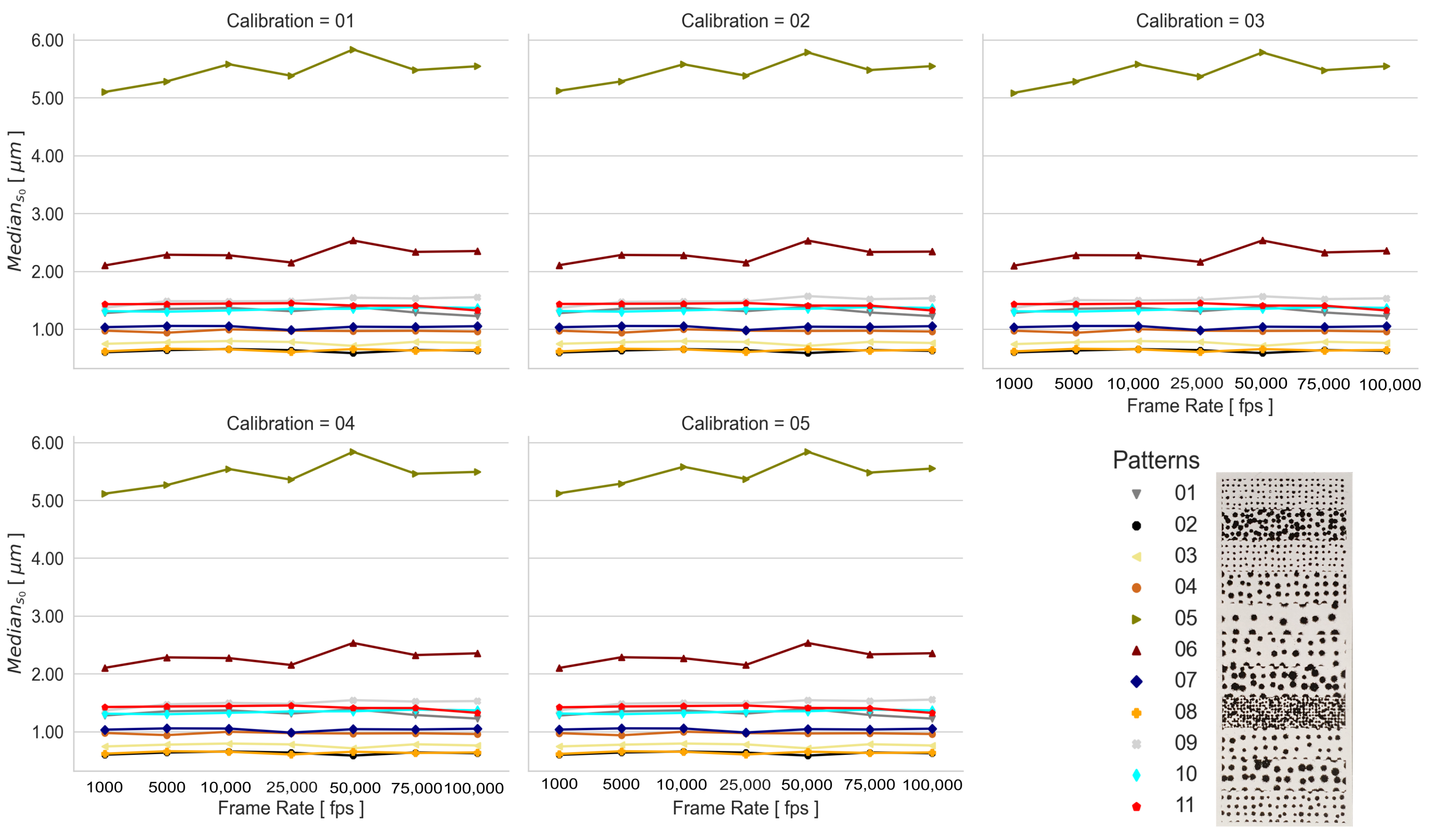
Appendix B
Appendix B.1
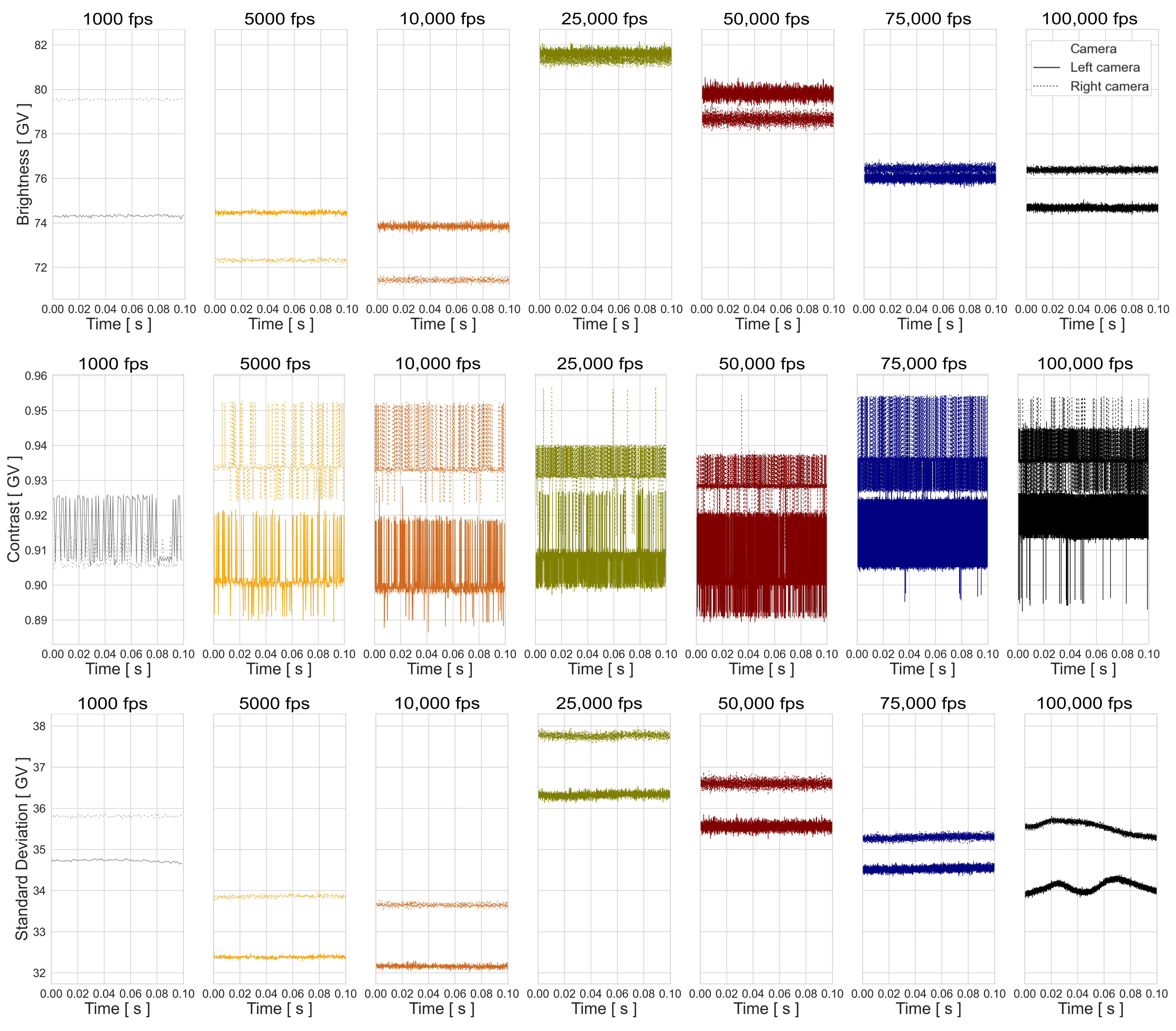
Appendix B.2
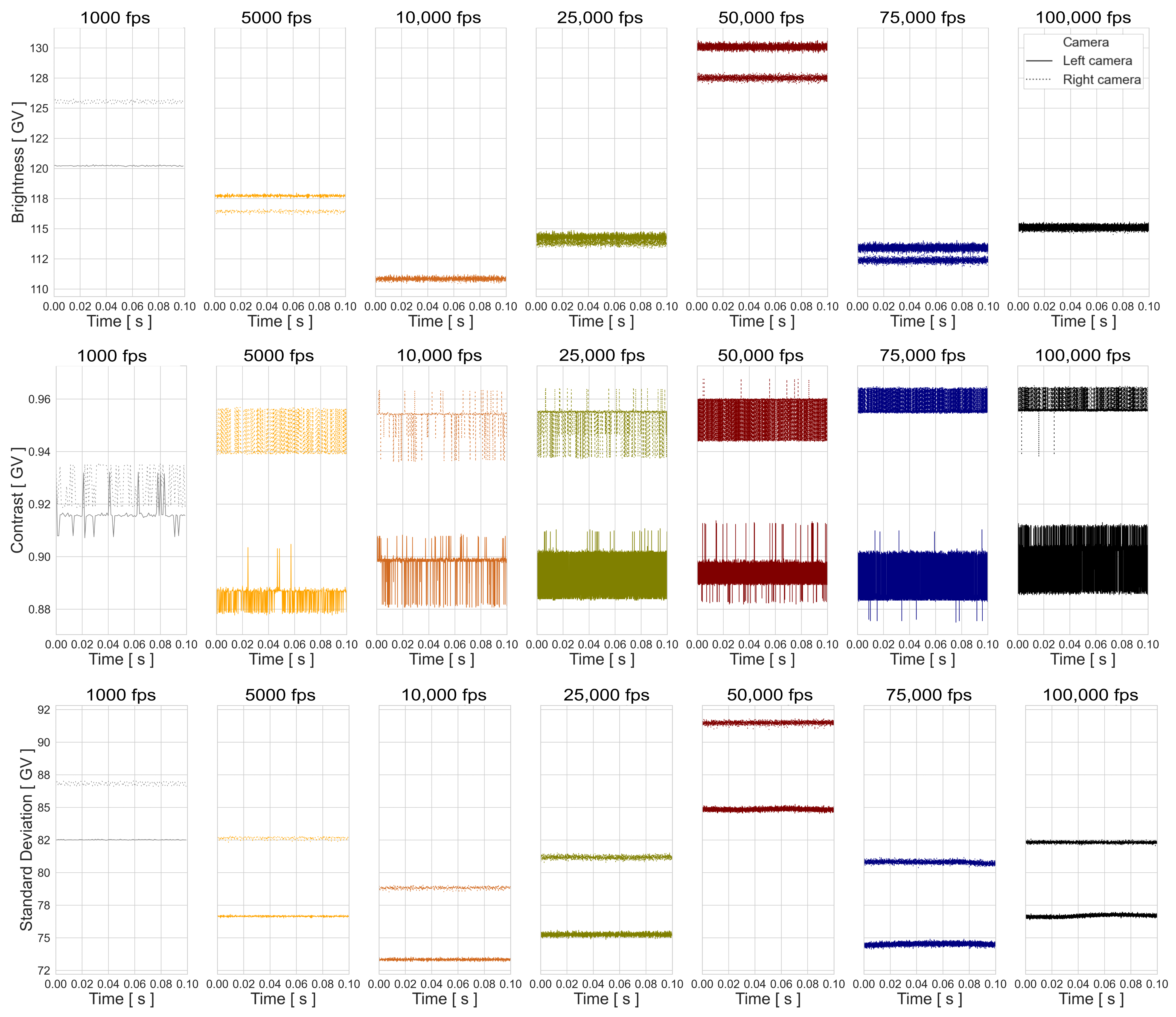
Appendix B.3
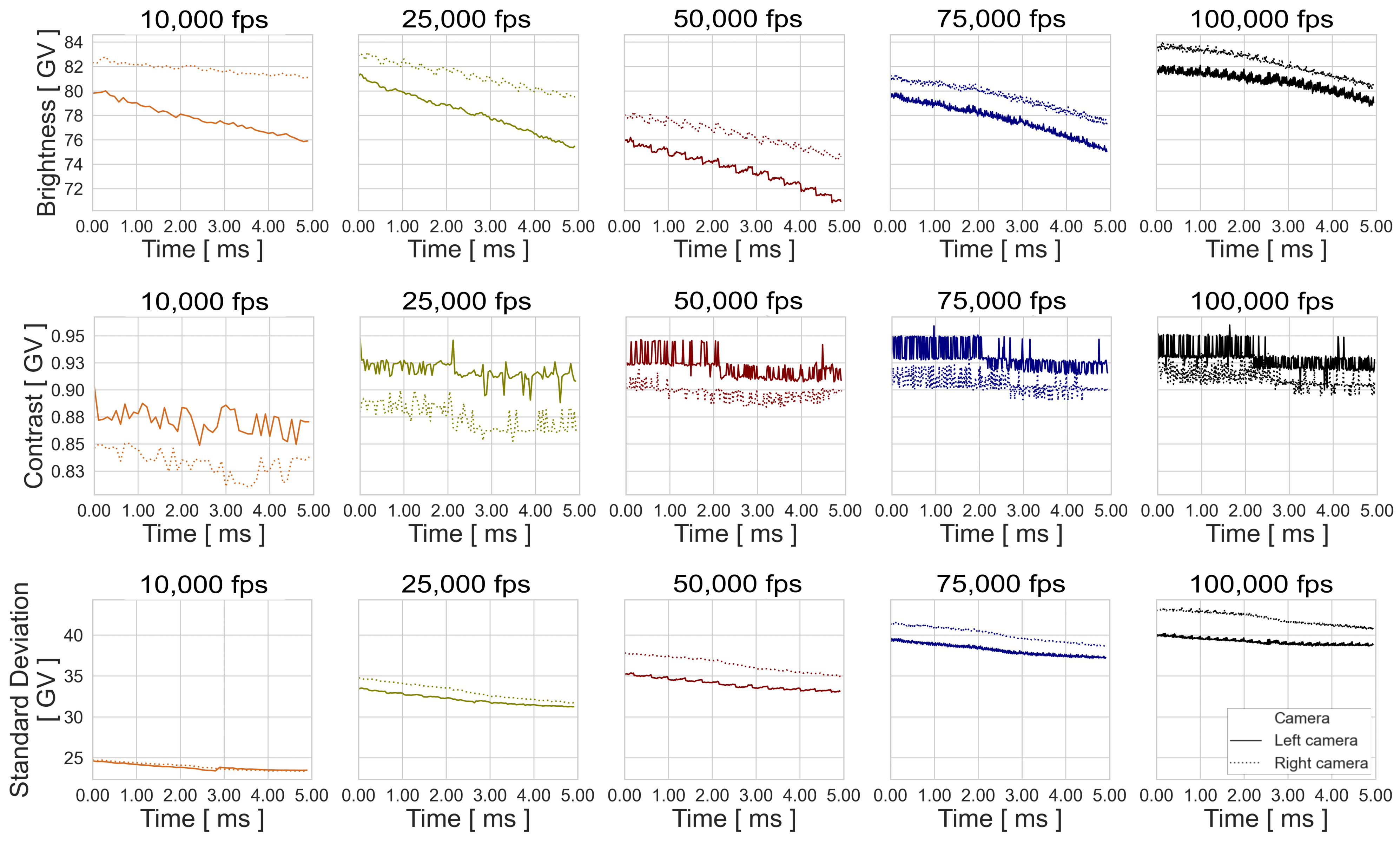
Appendix B.4
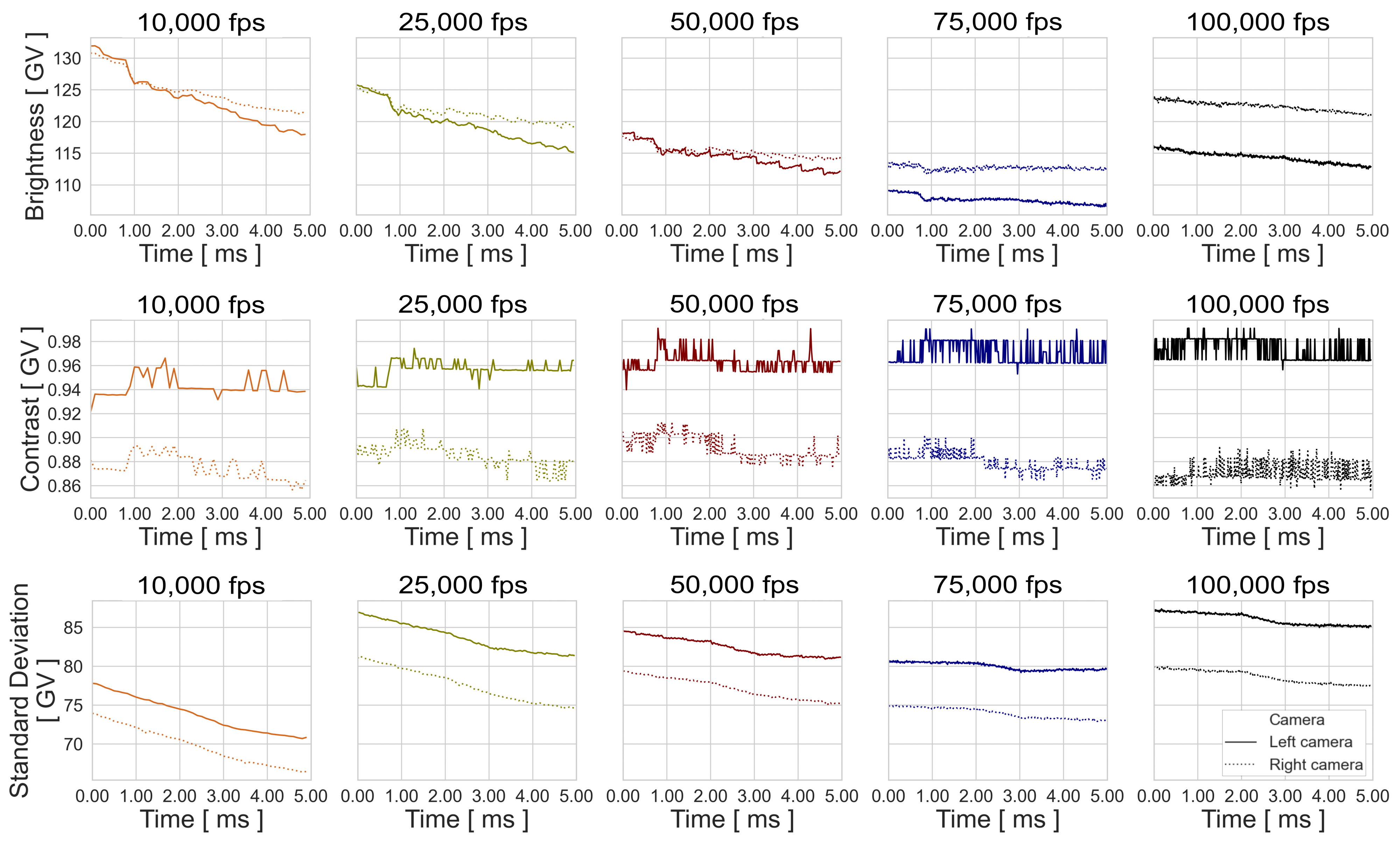
References
- Baqersad, J.; Poozesh, P.; Niezrecki, C.; Avitabile, P. Photogrammetry and optical methods in structural dynamics—A review. Mech. Syst. Signal Process. 2017, 86, 17–34. [Google Scholar] [CrossRef]
- Gong, T.; Heravi, A.A.; Alsous, G.; Curosu, I.; Mechtcherine, V. The Impact-Tensile Behavior of Cementitious Composites Reinforced with Carbon Textile and Short Polymer Fibers. Appl. Sci. 2019, 9, 4048. [Google Scholar] [CrossRef]
- Heravi, A.A.; Curosu, I.; Mechtcherine, V. A gravity-driven split Hopkinson tension bar for investigating quasi-ductile and strain-hardening cement-based composites under tensile impact loading. Cem. Concr. Compos. 2020, 105, 103430. [Google Scholar] [CrossRef]
- Tawfik, A.; Curosu, I.; Alsous, G.; Mechtcherine, V. A testing device to investigate the properties of strain-hardening, cement-based composites (SHCC) under impact shear loading. Int. J. Impact Eng. 2022, 167, 104280. [Google Scholar] [CrossRef]
- Barazzetti, L.; Scaioni, M. Development and Implementation of Image-based Algorithms for Measurement of Deformations in Material Testing. Sensors 2010, 10, 7469–7495. [Google Scholar] [CrossRef] [PubMed]
- Liebold, F.A.; Heravi, A.; Mosig, O.; Curbach, M.; Mechtcherine, V.; Maas, H.G. Crack Propagation Velocity Determination by High-speed Camera Image Sequence Processing. Materials 2020, 13, 4415. [Google Scholar] [CrossRef] [PubMed]
- Lange, J.; Benning, W.; Siering, K. Crack Detection at Concrete Construction Units from Photogrammetric Data using Image Processing Procedures. In Proceedings of the 9th European Conference on NonDestructive Testing 2006, Berlin, Germany, 25–29 September 2006; pp. 493–496. [Google Scholar]
- D’Emilia, G.; Razzè, L.; Zappa, E. Uncertainty analysis of high frequency image-based vibration measurements. Measurement 2013, 46, 2630–2637. [Google Scholar] [CrossRef]
- Busca, G.; Ghislanzoni, G.; Zappa, E. Indexes for performance evaluation of cameras applied to dynamic measurements. Measurement 2014, 51, 182–196. [Google Scholar] [CrossRef]
- Zappa, E.; Mazzoleni, P.; Matinmanesh, A. Uncertainty assessment of digital image correlation method in dynamic applications. Opt. Lasers Eng. 2014, 56, 140–151. [Google Scholar] [CrossRef]
- Zappa, E.; Matinmanesh, A.; Mazzoleni, P. Evaluation and improvement of digital image correlation uncertainty in dynamic conditions. Opt. Lasers Eng. 2014, 59, 82–92. [Google Scholar] [CrossRef]
- Zappa, E.; Hasheminejad, N. Digital Image Correlation Technique in Dynamic Applications on Deformable Targets. Exp. Tech. 2017, 41, 377–387. [Google Scholar] [CrossRef]
- Lavatelli, A.; Turrisi, S.; Zappa, E. A motion blur compensation algorithm for 2D DIC measurements of deformable bodies. Meas. Sci. Technol. 2018, 30, 025401. [Google Scholar] [CrossRef]
- Manin, J.; Skeen, S.A.; Pickett, L.M. Performance comparison of state-of-the-art high-speed video cameras for scientific applications. Opt. Eng. 2018, 57, 1. [Google Scholar] [CrossRef]
- Mechtcherine, V.; Curosu, I. Mineral-Bonded Composites for Enhanced Structural Impact Safety—A New Research Training Group GRK 2250 of the German Research Society. Procedia Eng. 2017, 210, 182–185. [Google Scholar] [CrossRef]
- Gorjup, D.; Slavic, J.; Boltežar, M. 2022. Available online: https://github.com/ladisk/speckle_pattern (accessed on 8 December 2022).
- Photron. Fastcam SA-X2. Datasheet, Photron. Available online: https://photron.com/fastcam-sa-x2/ (accessed on 8 December 2022).
- Luhmann, T.; Fraser, C.; Maas, H.G. Sensor modelling and camera calibration for close-range photogrammetry. ISPRS J. Photogramm. Remote Sens. 2016, 115, 37–46. [Google Scholar] [CrossRef]
- Luhmann, T.; Robson, S.; Kyle, S.; Boehm, J. Close-Range Photogrammetry and 3D Imaging, 3rd ed.; De Gruyter: Boston, MA, USA, 2020. [Google Scholar] [CrossRef]

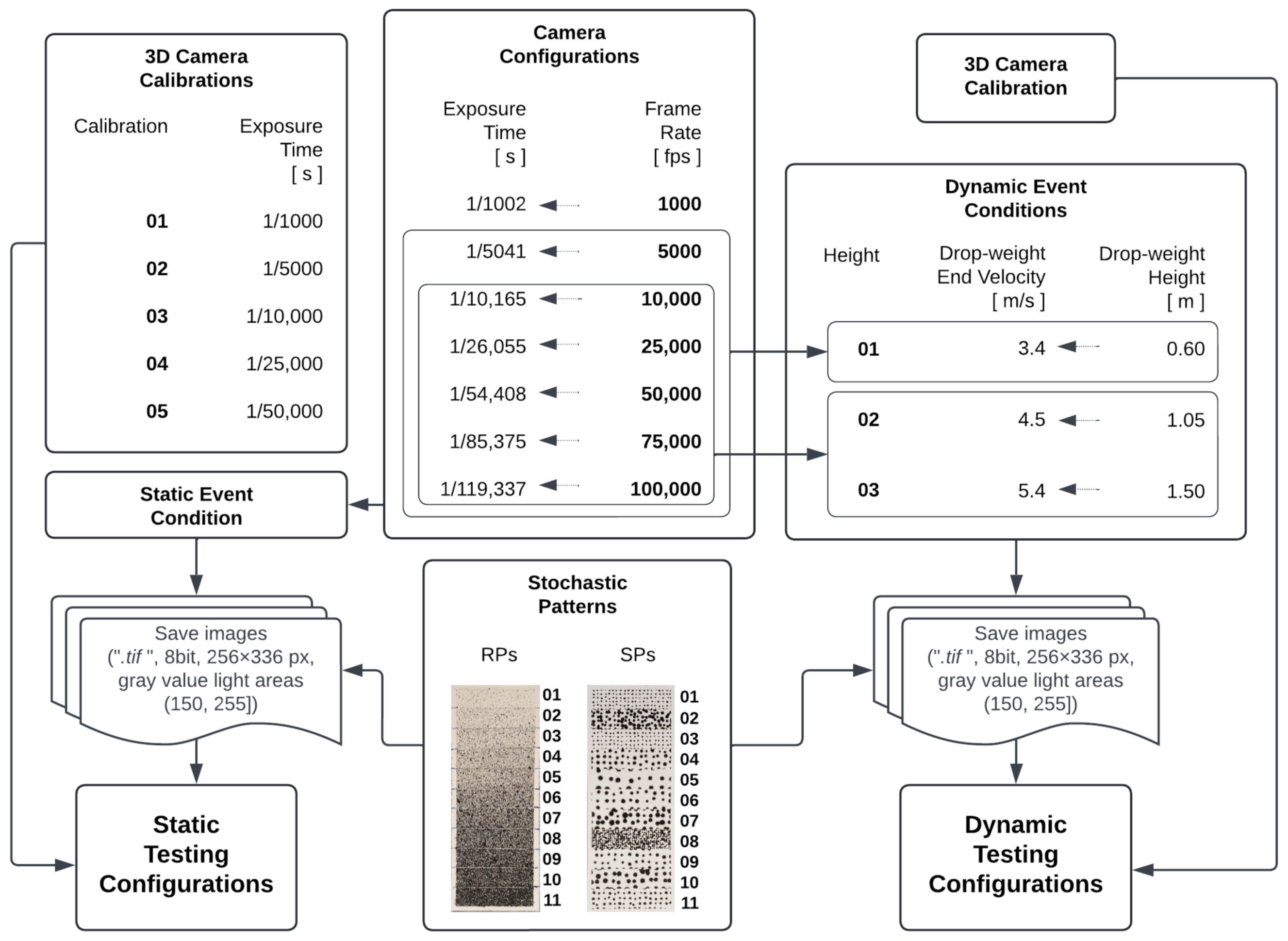

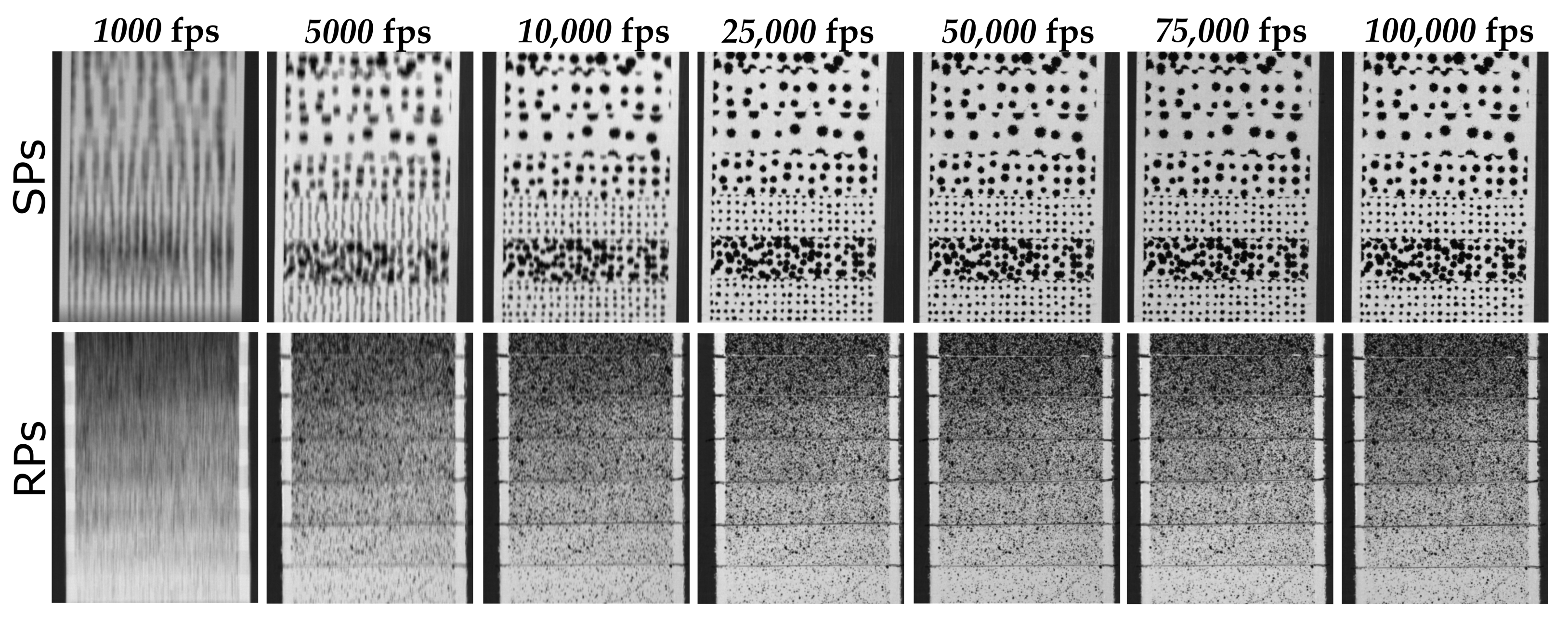
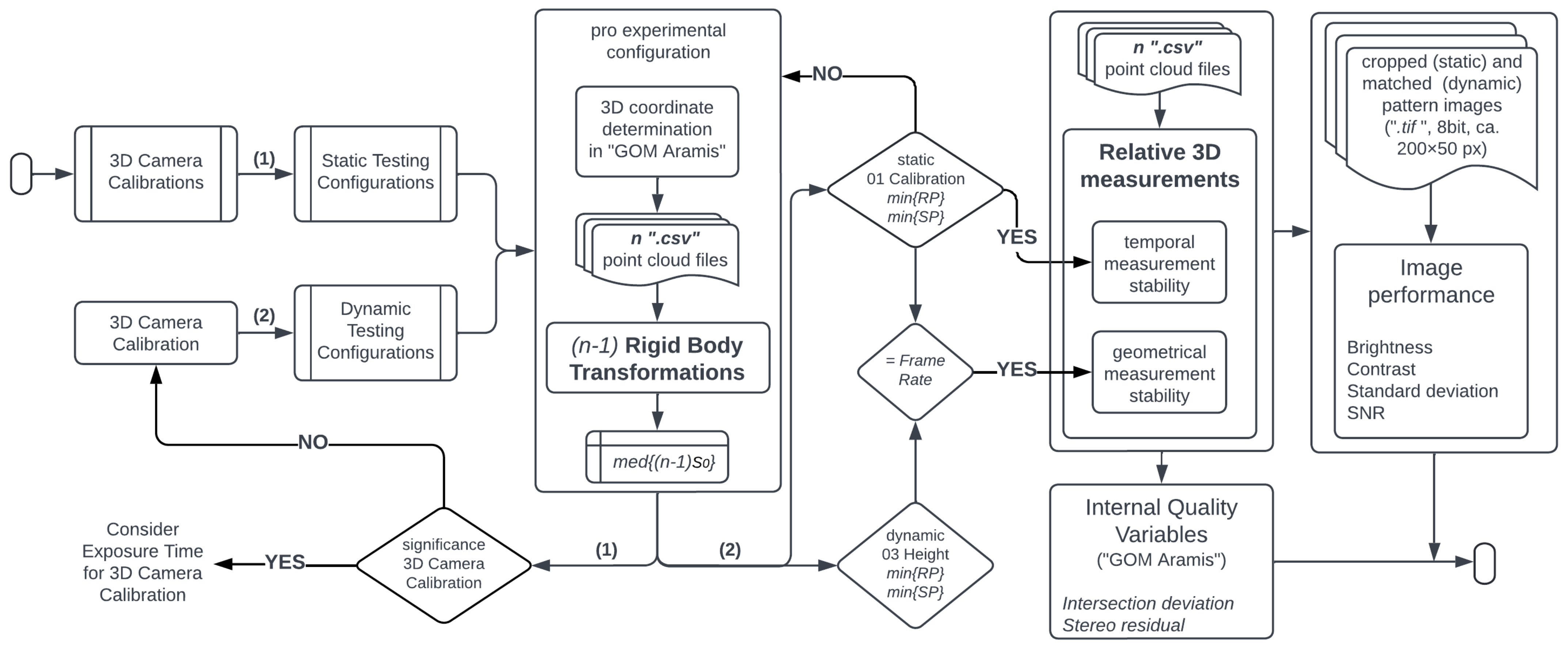
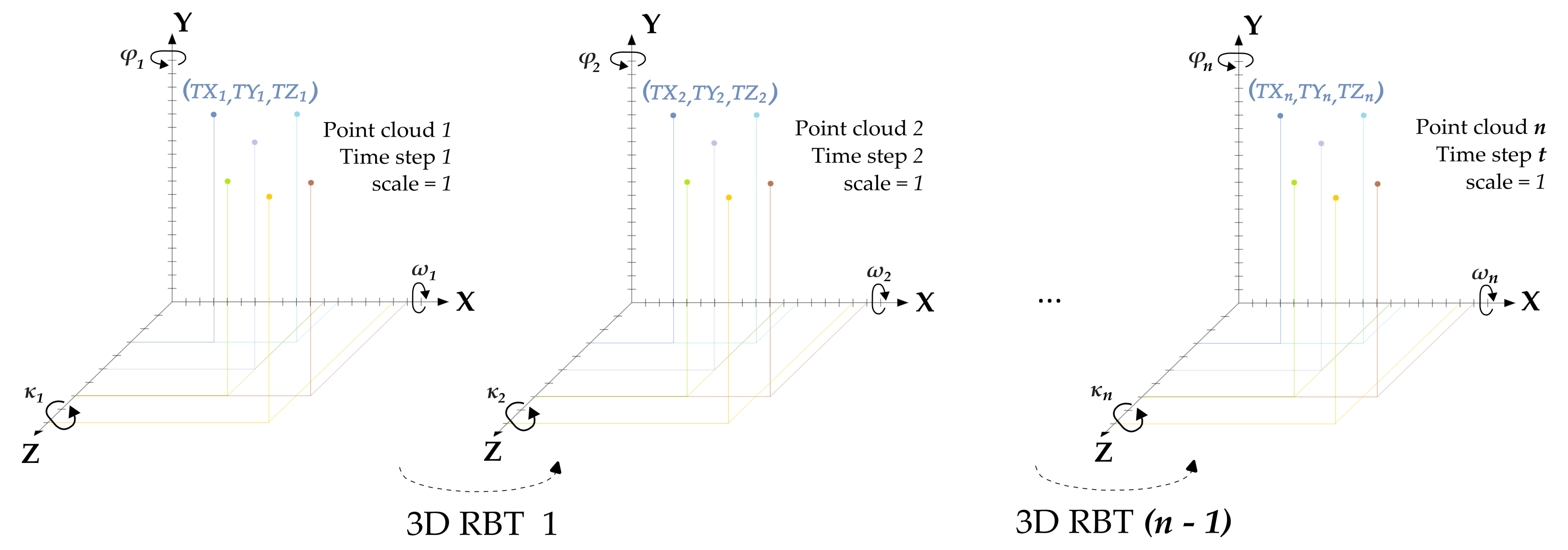









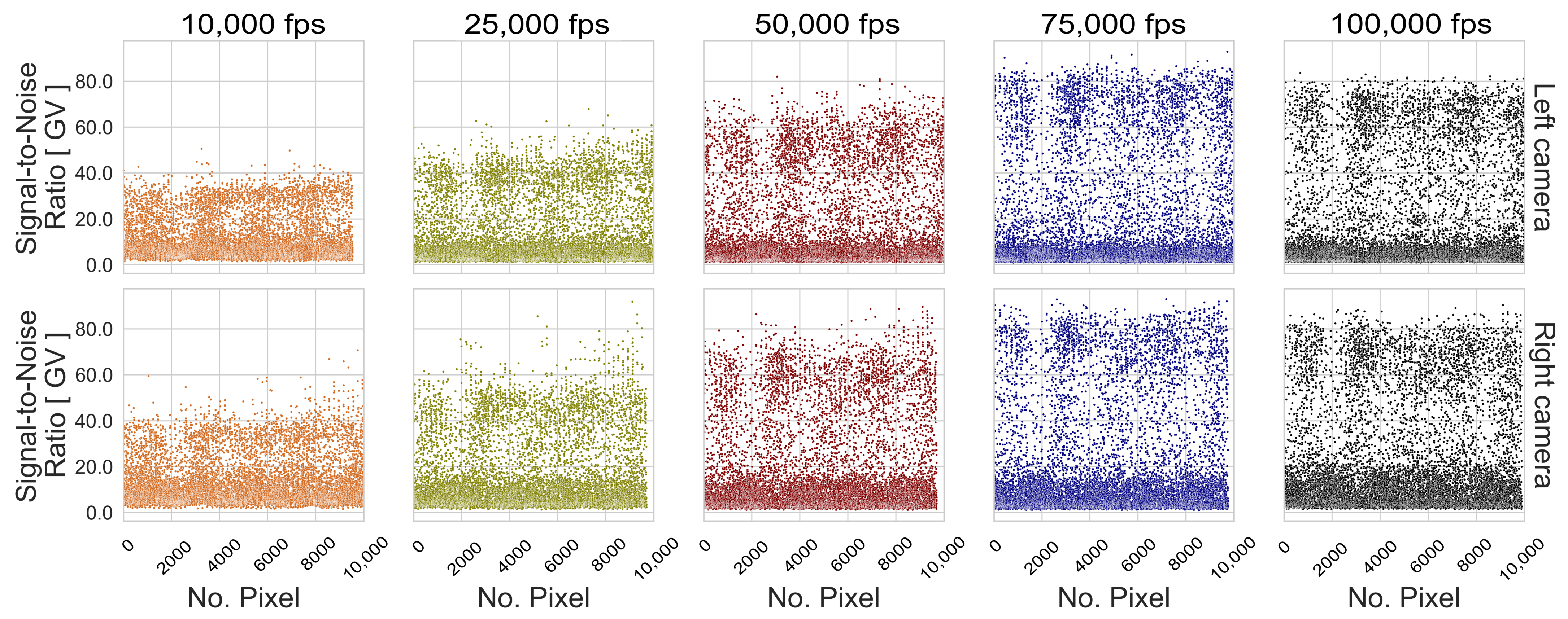

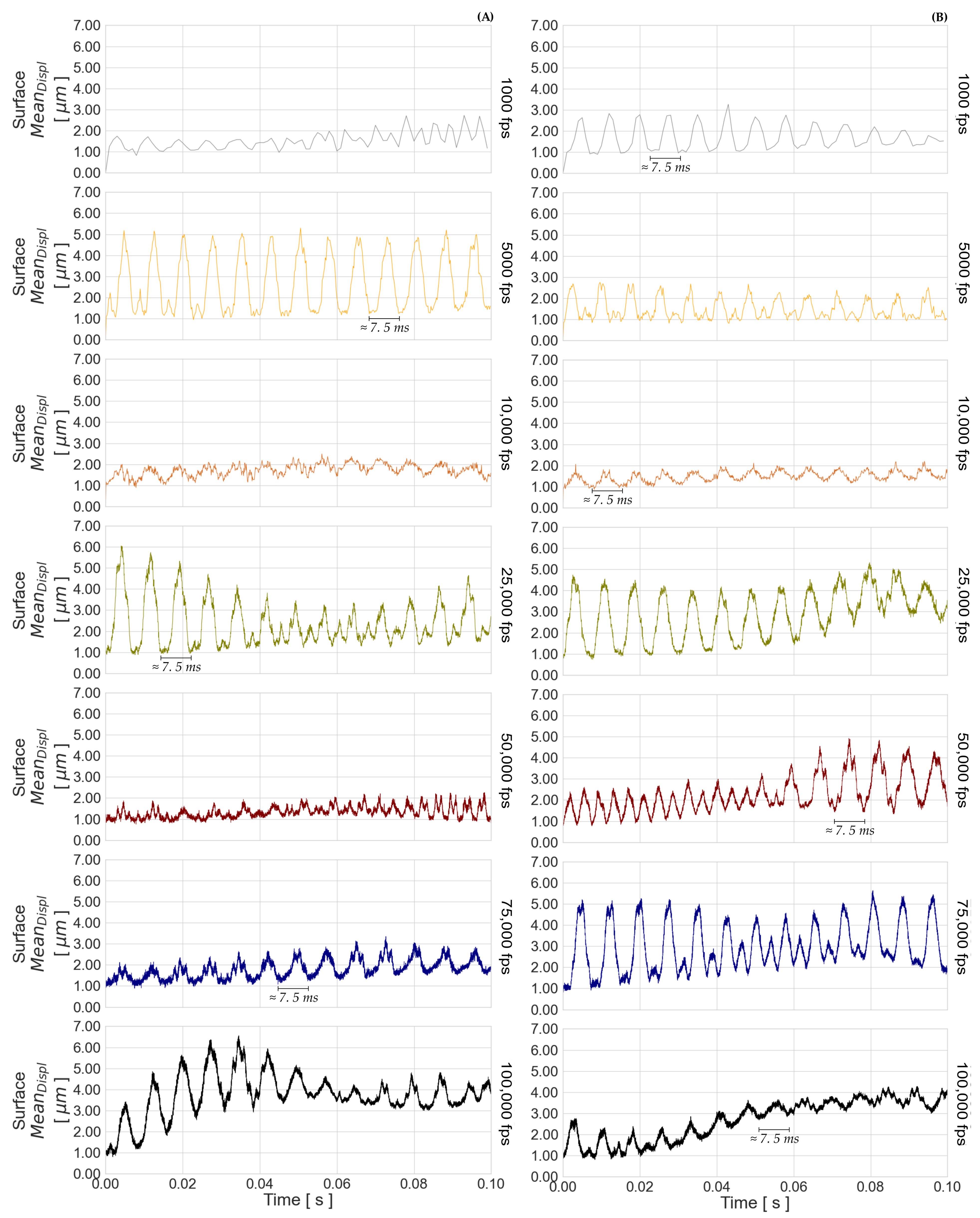



| Sensor Technology | Proprietary Design Advanced CMOS |
|---|---|
| Sensor Type | Monochrome |
| Full Sensor resolution | px at fps |
| Maximum Frame Rate | fps for 128 px × px |
| Sensor Size | mm |
| Sensor Diagonal | mm |
| Pixel (px) Size | m |
| Fill Factor (photosensitive area/pixel size) | 58% |
| Minimum Exposure Time | Global electronic shutter to 1 s |
| Light Sensitivity | ISO |
| Quantum Efficiency (% photons converted to photo-electrons) | 46% at 630 nm |
| Event Condition | # Camera Calibration | Height | # Frame Rate | # Stochastic Patterns | # Experimental Configurations |
|---|---|---|---|---|---|
| Static | 5 | – | 7 | 11 SP & 11 RP | 770 |
| 01 | 6 | 132 | |||
| Dynamic | 1 | 02 | 5 | 11 SP & 11 RP | 110 |
| 03 | 5 | 110 |
| 10,000 fps | 25,000 fps | 50,000 fps | 75,000 fps | 100,000 fps | |||
|---|---|---|---|---|---|---|---|
| Static | 5.28 | 5.58 | 5.38 | 5.84 | 5.48 | 5.55 | |
| SP 05 | 01 Height | 7.81 | 7.68 | 5.52 | 7.17 | 7.90 | 7.91 |
| 02 Height | – | 7.31 | 6.19 | 5.72 | 7.91 | 8.43 | |
| 03 Height | – | 7.29 | 6.65 | 5.84 | 9.82 | 7.89 | |
| Static | 0.64 | 0.66 | 0.64 | 0.59 | 0.64 | 0.63 | |
| SP 02 | 01 Height | 1.00 | 0.79 | 0.68 | 1.39 | 1.59 | 1.51 |
| 02 Height | – | 0.88 | 0.77 | 0.75 | 1.43 | 1.52 | |
| 03 Height | – | 0.95 | 0.78 | 0.74 | 1.68 | 1.48 | |
| Static | 1.50 | 1.45 | 1.57 | 1.67 | 2.66 | 1.80 | |
| RP 01 | 01 Height | 3.56 | 2.12 | 2.10 | 2.78 | 2.80 | 2.85 |
| 02 Height | – | 2.75 | 1.75 | 1.79 | 2.77 | 2.92 | |
| 03 Height | – | 3.21 | 2.07 | 1.92 | 2.30 | 2.84 | |
| Static | 0.73 | 0.74 | 0.68 | 0.67 | 0.69 | 0.70 | |
| RP 06 | 01 Height | 1.52 | 0.86 | 1.13 | 1.90 | 2.10 | 2.07 |
| 02 Height | – | 1.11 | 0.82 | 0.88 | 1.91 | 2.23 | |
| 03 Height | – | 1.35 | 0.80 | 0.76 | 1.45 | 1.93 |
| RP 06 | ||||||||
|---|---|---|---|---|---|---|---|---|
| Frame Rate | || | |||||||
| 1000 fps | [0.00, 2.73] | 2.73 | [ 0.00, 0.91] | 0.91 | [−0.57, 0.01] | 0.58 | [−2.60, 2.59] | 5.19 |
| 5000 fps | [0.00, 5.30] | 5.30 | [−1.03, 0.58] | 1.61 | [−0.26, 0.33] | 0.59 | [−5.26, 2.19] | 7.45 |
| fps | [0.00, 2.50] | 2.50 | [−1.61, 0.07] | 1.68 | [−0.12, 1.11] | 1.23 | [−0.41, 1.81] | 2.22 |
| fps | [0.00, 6.05] | 6.05 | [−0.83, 1.62] | 2.45 | [−0.84, 0.25] | 1.09 | [−2.01, 6.00] | 8.01 |
| fps | [0.00, 2.26] | 2.26 | [−0.86, 0.33] | 1.19 | [−0.28, 0.56] | 0.84 | [−2.17, 2.05] | 4.22 |
| fps | [0.00, 3.35] | 3.35 | [−0.31, 1.47] | 1.78 | [−0.41, 0.58] | 0.99 | [−3.14, 0.77] | 3.91 |
| fps | [0.00, 6.55] | 6.55 | [−3.91, 0.15] | 4.06 | [−1.76, 0.70] | 2.46 | [−3.19, 6.03] | 9.22 |
| SP 02 | ||||||||
|---|---|---|---|---|---|---|---|---|
| Frame Rate | || | |||||||
| 1000 fps | [0.00, 3.27] | 3.27 | [−0.74, 0.11] | 0.85 | [−0.37, 0.69] | 1.06 | [−3.21, 0.61] | 3.82 |
| 5000 fps | [0.00, 2.75] | 2.75 | [−0.28, 0.46] | 0.74 | [−0.24, 0.61] | 0.85 | [−1.45, 2.71] | 4.16 |
| fps | [0.00, 2.20] | 2.20 | [−0.21, 1.42] | 1.63 | [−0.45, 0.36] | 0.81 | [−0.63, 1.88] | 2.51 |
| fps | [0.00, 5.32] | 5.32 | [−0.19, 0.96] | 1.15 | [−0.90, 0.35] | 1.25 | [−0.70, 5.30] | 6.00 |
| fps | [0.00, 4.92] | 4.92 | [−0.92, 0.36] | 1.28 | [−1.67, 0.22] | 1.89 | [−2.79, 4.74] | 7.53 |
| fps | [0.00, 5.63] | 5.63 | [−1.31, 0.09] | 1.40 | [−1.96, 0.25] | 2.21 | [−5.24, 3.15] | 8.39 |
| fps | [0.00, 4.28] | 4.28 | [−0.07, 2.75] | 2.82 | [−2.25, 0.23] | 2.48 | [−1.51, 3.00] | 4.51 |
Disclaimer/Publisher’s Note: The statements, opinions and data contained in all publications are solely those of the individual author(s) and contributor(s) and not of MDPI and/or the editor(s). MDPI and/or the editor(s) disclaim responsibility for any injury to people or property resulting from any ideas, methods, instructions or products referred to in the content. |
© 2023 by the authors. Licensee MDPI, Basel, Switzerland. This article is an open access article distributed under the terms and conditions of the Creative Commons Attribution (CC BY) license (https://creativecommons.org/licenses/by/4.0/).
Share and Cite
Duran Vergara, L.C.; Liebold, F.; Maas, H.-G. Analysis of the Accuracy Potential of a Stereo High-Speed Camera System in 3D Measurements in Highly Dynamic Experiments. Sensors 2023, 23, 2158. https://doi.org/10.3390/s23042158
Duran Vergara LC, Liebold F, Maas H-G. Analysis of the Accuracy Potential of a Stereo High-Speed Camera System in 3D Measurements in Highly Dynamic Experiments. Sensors. 2023; 23(4):2158. https://doi.org/10.3390/s23042158
Chicago/Turabian StyleDuran Vergara, Laura Camila, Frank Liebold, and Hans-Gerd Maas. 2023. "Analysis of the Accuracy Potential of a Stereo High-Speed Camera System in 3D Measurements in Highly Dynamic Experiments" Sensors 23, no. 4: 2158. https://doi.org/10.3390/s23042158
APA StyleDuran Vergara, L. C., Liebold, F., & Maas, H.-G. (2023). Analysis of the Accuracy Potential of a Stereo High-Speed Camera System in 3D Measurements in Highly Dynamic Experiments. Sensors, 23(4), 2158. https://doi.org/10.3390/s23042158






